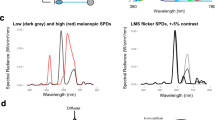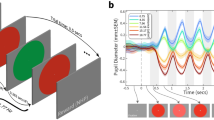Abstract
Latency of pupillary responses to light stimuli are smaller for larger steps of light, and larger for smaller steps of light (Alpern 1954; Lowenstein et al. 1964; Lee et al. 1969; Terdiman et al. 1969; Cibis et al. 1977; and many others). Miller and Thompson (1978), however, reported negligible change in pupil cycle time (period of high gain instability oscillations) with increased mean brightness. Sandberg and Stark (1968) reportd a negligible reduction in phase lag of pupillary responses to sinusoidal light stimuli as the modulation coefficient (m) increased. To resolve the inconsistency between the well-documented dependence of latency upon brightness, and the apparent absence of level dependence in the phase characteristics (as reflected directly in the responses to sinusoidal stimuli and indirectly in pupil cycle time experiments) we measured: 1. Latency to step stimuli of light, 2. Phase of responses to sinusoidal light stimuli and 3. Period (pupil cycle time) of high gain instability oscillations. The dependence of pupillary latency upon stimulus level (both light and accommodation) and the interaction between accommodation and light responses were investigated. We show that most of the level dependence of light-pupil latency resides in the afferent path. In the companion papers, we demonstrate that: 1. Phase of pupillary response to sinusoidal light stimuli is reduced by increased mean light level, but is independent of pupil size and accommodative stimulus level; and 2. The period of high gain oscillations is shown to decrease with increased mean light level. Taken together, these results imply the existence of a Level Dependent Signal Flow (LDSF) operator that resides in the light-pupil pathway, but not in the accommodation-pupil pathway. We propose a systems model of this operator in which the neural signals controlling pupil size are treated as waves whose phase velocity increases in response to brighter stimuli, and decreases in response to dimmer stimuli. When parameters of the model are adjusted to fit measured pupillary latency over a range of light levels, the model exhibits reduced phase lag in response to increased mean light level in the sinusoidal paradigm, and it exhibits reduced pupil cycle time in the high-gain oscillation paradigm. The model exhibits saturation of the LDSF effect in all paradigms at high light levels, as do experimental results. It simulates directional asymmetry of pupillary response to positive and negative steps of light, with constriction more rapid than dilatation. Finally, it simulates tonic pupillary constriction in response to modulation of a light simulus without changing average light level (Varju 1964; Troelstra 1968). All of these stimulated results are in accord with experimental observation.
Similar content being viewed by others
References
Alpern M (1954) The relation of visual latency to intensity. AMA Arch Ophthalmol 51:369–374
Cibis GW, Campos EC, Auhorn E (1977) Pupillomotor latent period. Vision Res 17:737–738
Ellis CJK (1981) The pupillary light reflex in normal subjects. Br J Ophthalmol 65:754–759
Fuortes MGF, Hodgkin AL (1964) Changes in time scale and sensitivity in the ommatidia of Limulus. J Physiol 172:239–263
Jansen JML (1952) Discontinuous low frequency low frequency delay line with continuously variable delay. Nature 169:148
Lee RE, Cohen G, Boynton RM (1969) Latency variation in human pupil contraction. J Opt Soc Am 59: 97–103
Lennie P (1981) The physiological basis of variations in visual latency. Vision Res 21:815–824
Link N, Stark L (1988) Latency of light-pupil reflex. IEEE Trans Biomeds Eng T-BME 35:214–218
Lowenstein OH, Kawabata, Loewenfeld I (1964) The pupil as an indicator of retinal activity. Am J Ophthalmol 57:569–596
Miller SD, Thompson HS (1978) Edge-light pupil cycle time. Br J Ophthalmol 62:495–502
Myers GA, Stark L (1990a) Light and target distance interact to control pupil size. Am J Physiol 258:R813-R819
Myers GA, Stark L (1990b) Topology of the near response triad. Opthalmol Physiol Opt 10:175–181
Myers GA, Sherman KR, Stark L (1991) Eye monitor: microcomputer based instrument uses an internal model to track the eye. Computer 24:14–21
Myers GA, Stark L (1993) Level dependent signal flow in the light pupil reflex: III Phase velocity of high gain instability oscillations68:241–246
Myers GA, Gannon JA, Stark L (1993) Level dependent signal flow in the light pupil reflex: II. Phase velocity of responses to sinusoidal light stimuli. Biol Cybern 68:235–240
Philbrick GA (1963) Bucket brigade time delay. In: Paynter HM (eds) On the electronic art. p 163
Sandberg A, Stark L (1968) Weiner G-function analysis as an approach to linear characteristics of human pupil light reflex. Brain Res 11: pp 194–211
Semmlow J, Hansmann D, Stark L (1974) Variation in pupillomotor responsiveness with mean pupil size. Vision Res 14:1–6
Stark L (1959) Stability, oscillations and noise in the pupillary servomechanism. Proc IRE 47:1925–1939
Stark L (1963) Black box description and physical element identification of the pupil. QPR M. I. T. Res. Lab. Electron 169:247–250
Terdiman J, Smith JD, Stark L (1969) Pupil response to light and lectrical stimulation: Static and dynamic characteristics. Brain Res 16:288–292
Usui S, and Stark L (1978) Sensory and motor mechanisms interact to control amplitude of pupil noise. Vision Res 18:505–507
Varju D (1964) Pupillenreaktionen auf sinusfurmige Leuchtdicheanderungen. Kybernetics 2:124
Author information
Authors and Affiliations
Rights and permissions
About this article
Cite this article
Myers, G.A., Stark, L. Level dependent signal flow in the light pupil reflex. Biol. Cybern. 68, 229–234 (1993). https://doi.org/10.1007/BF00224856
Received:
Accepted:
Issue Date:
DOI: https://doi.org/10.1007/BF00224856




